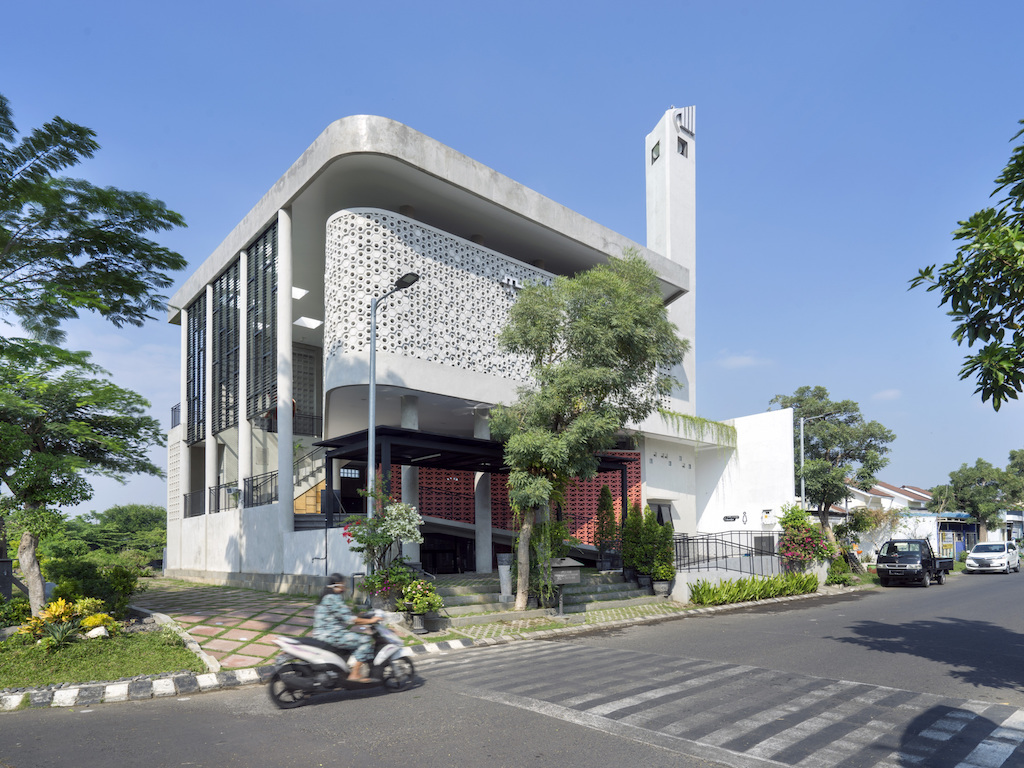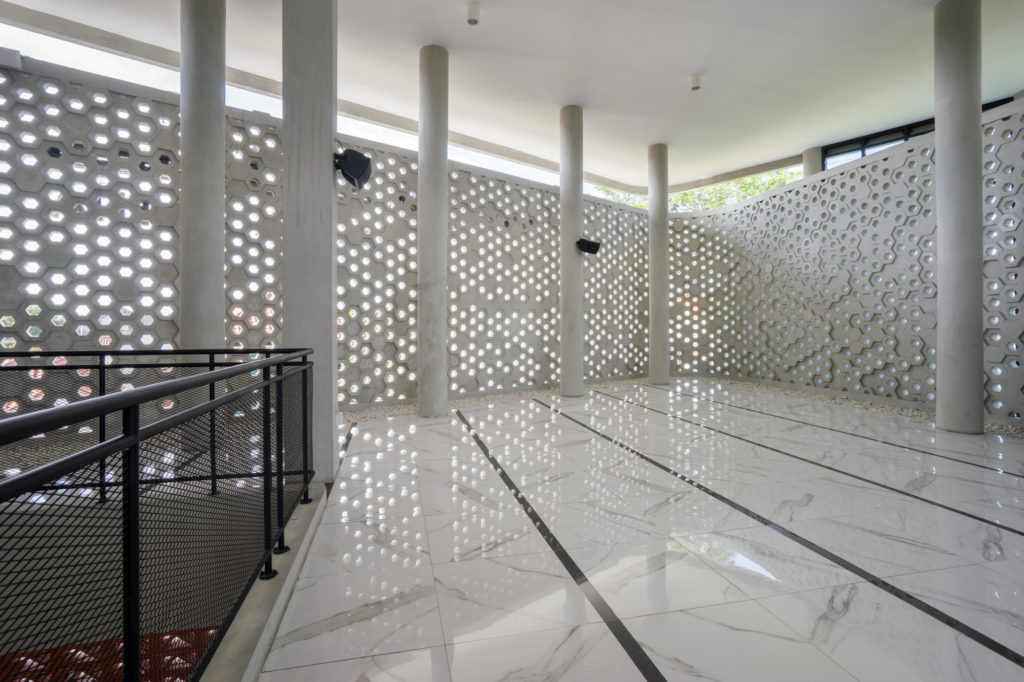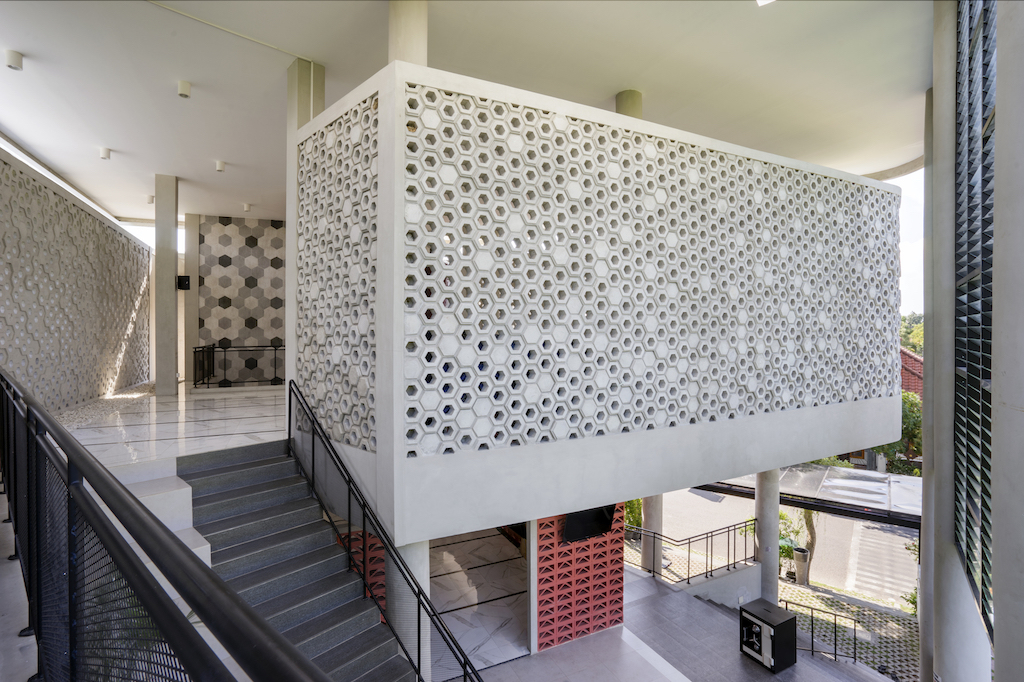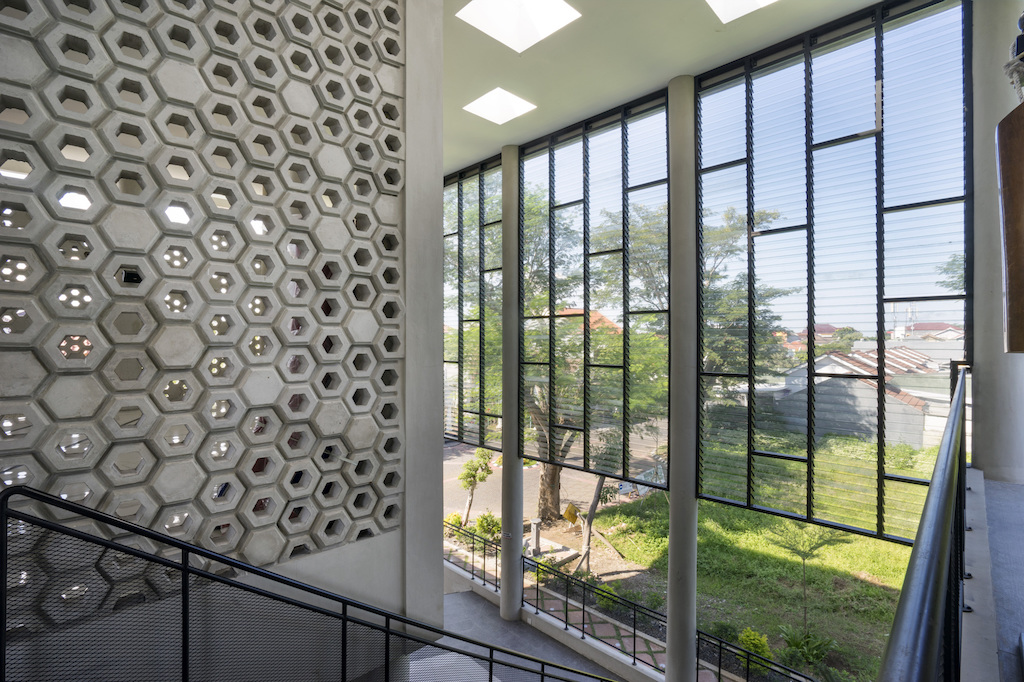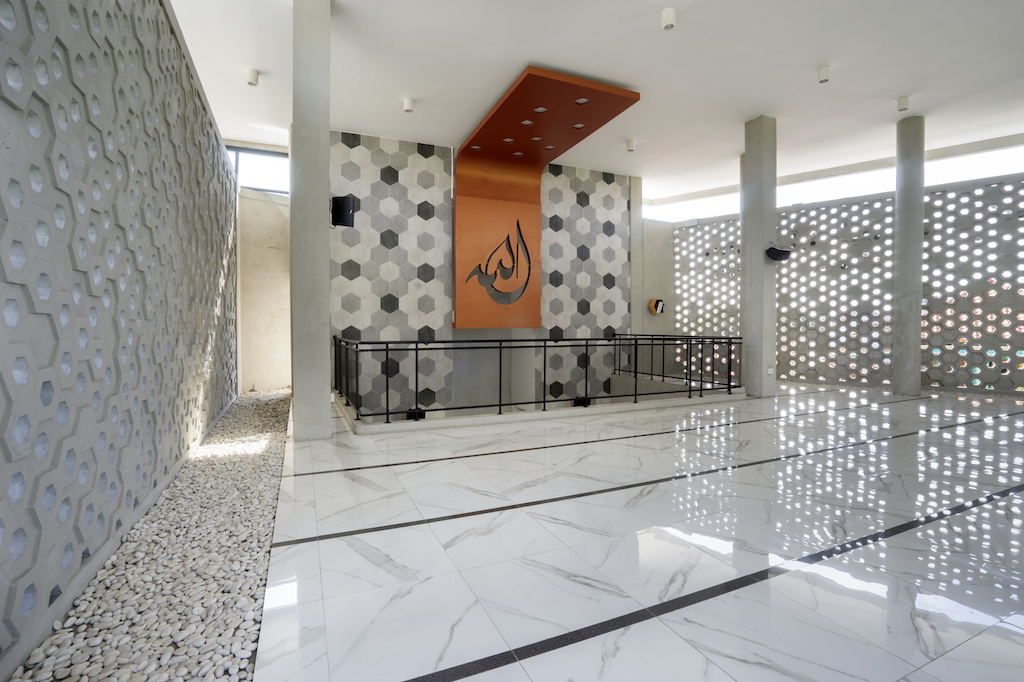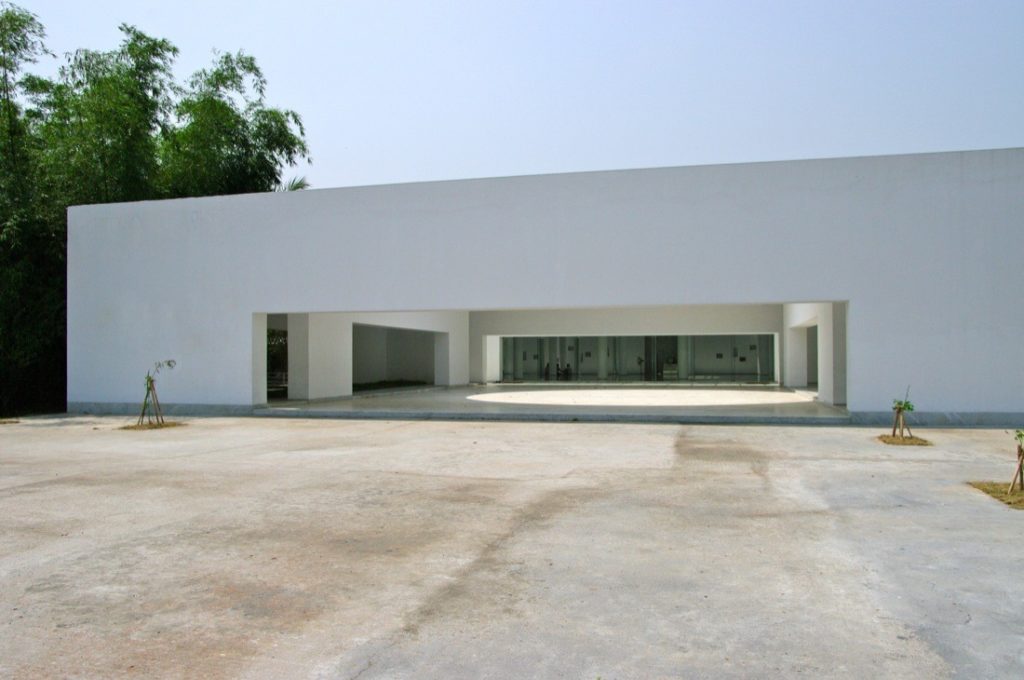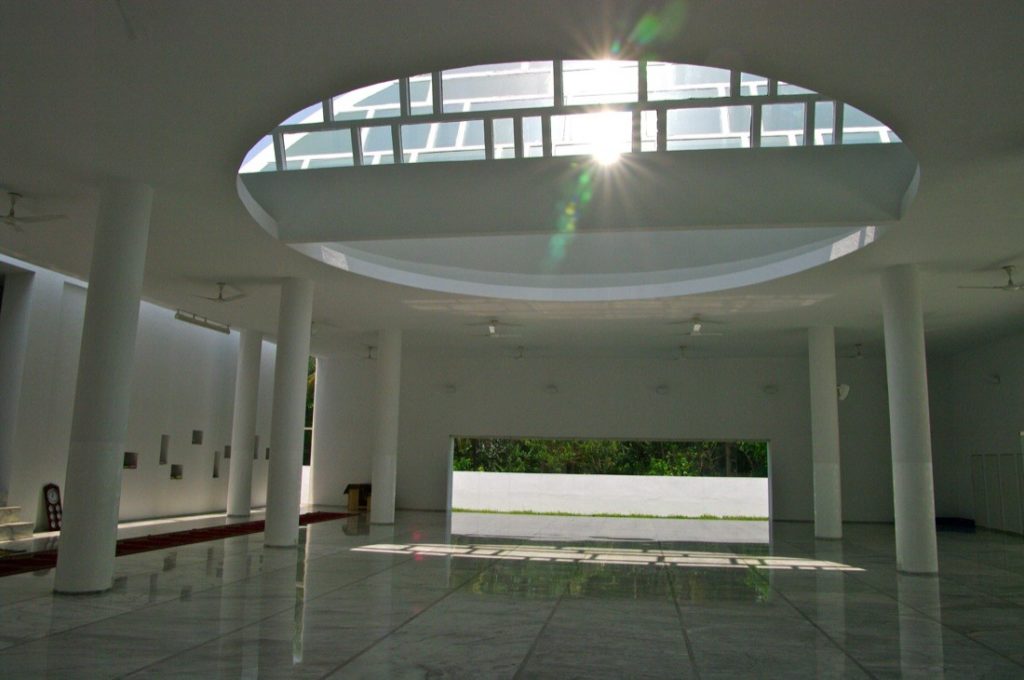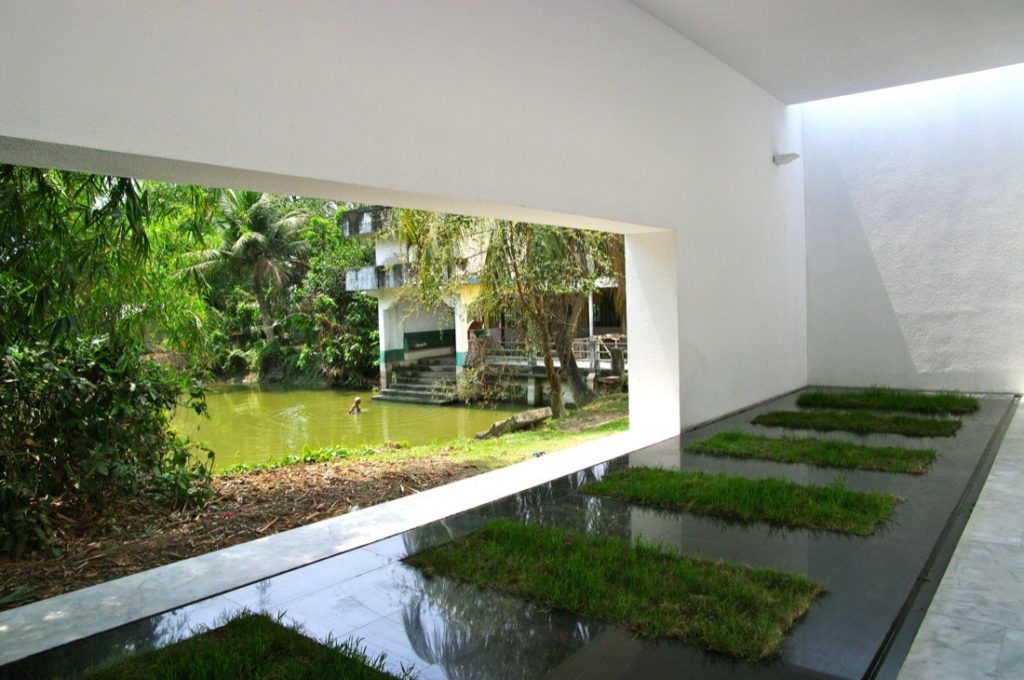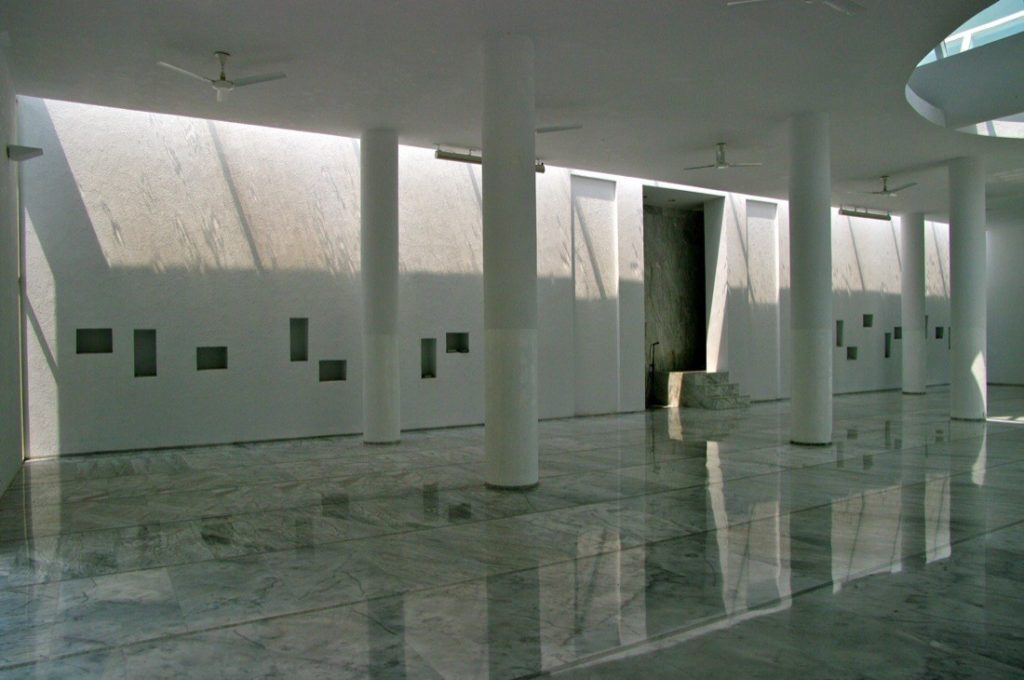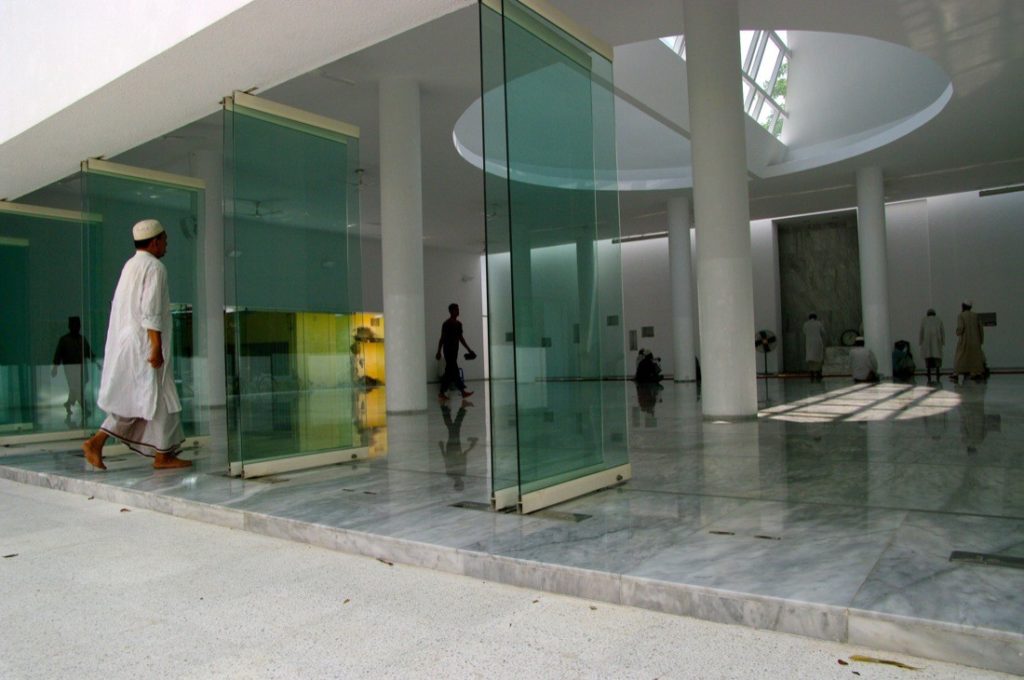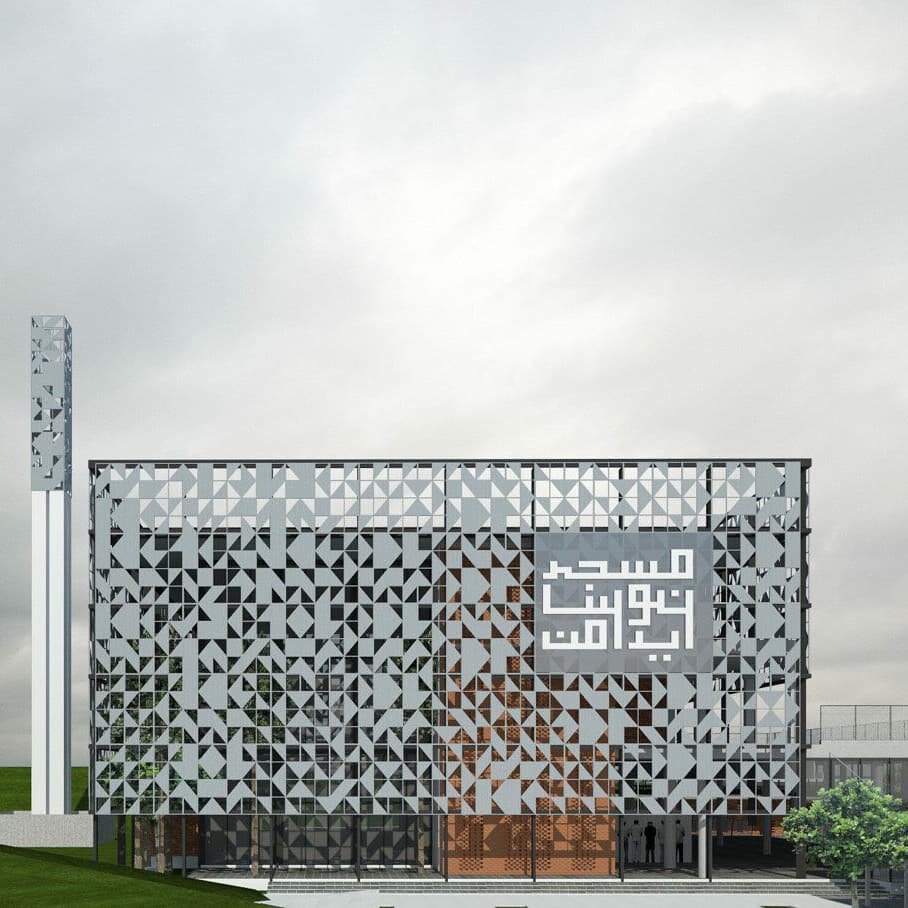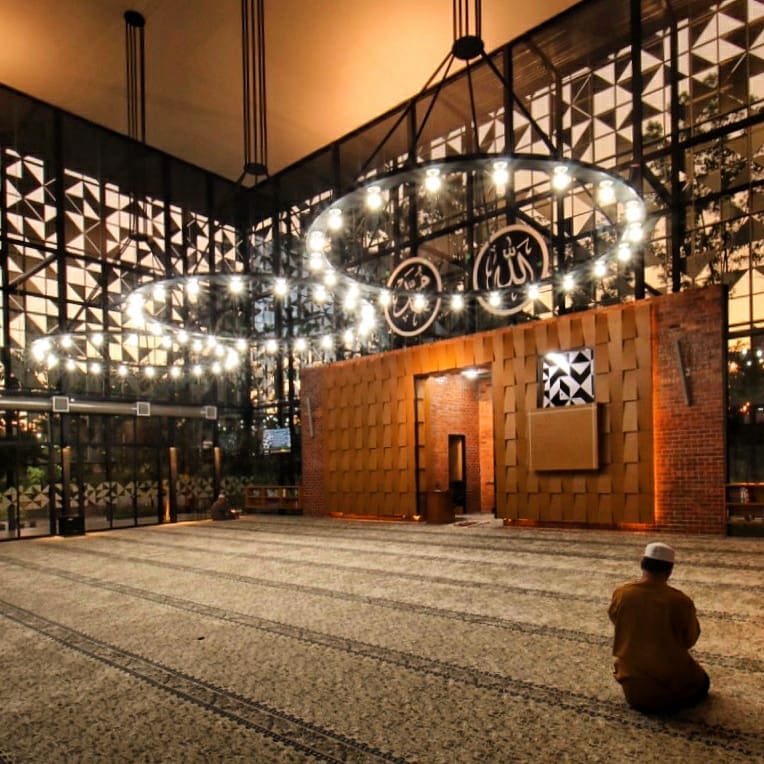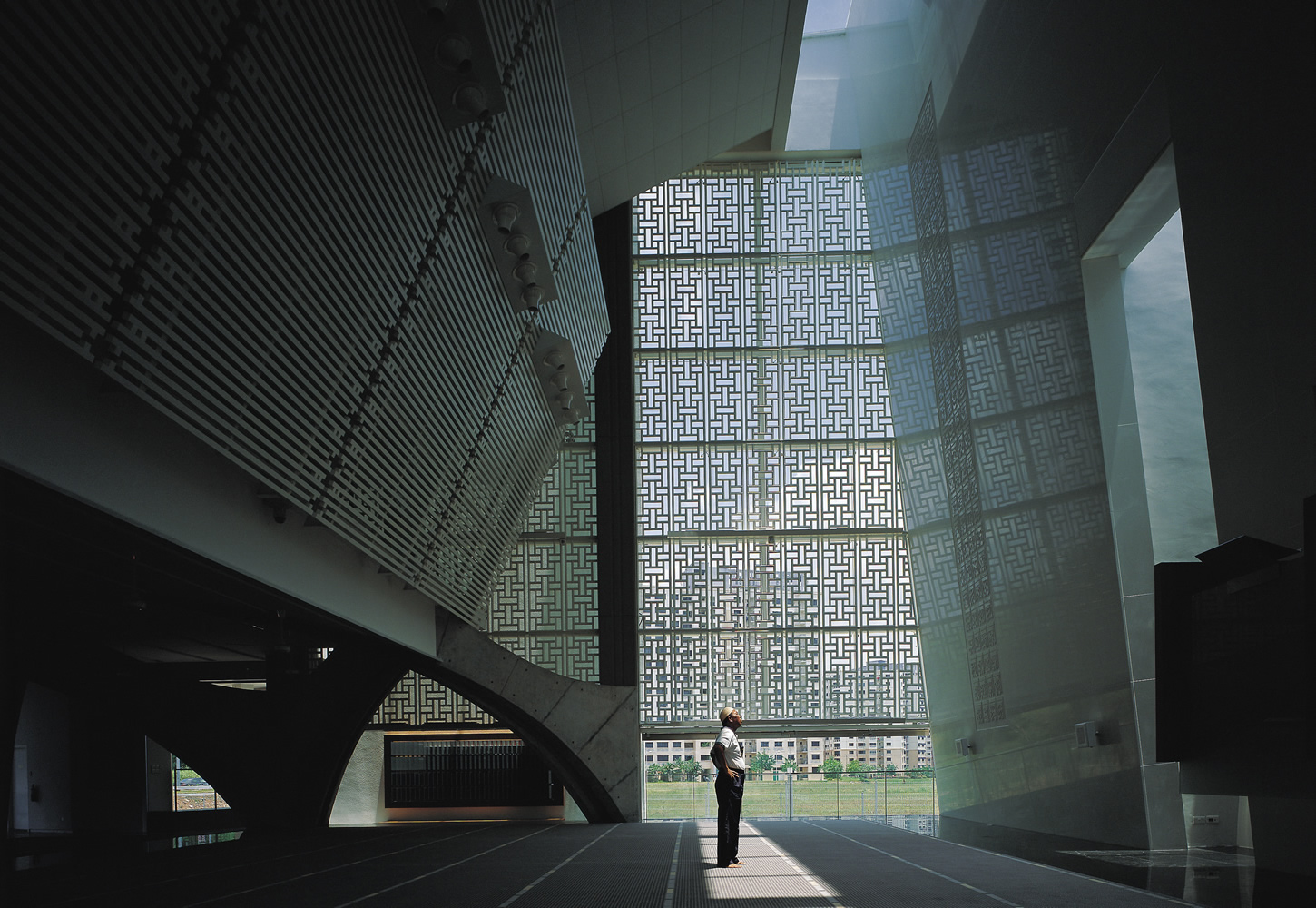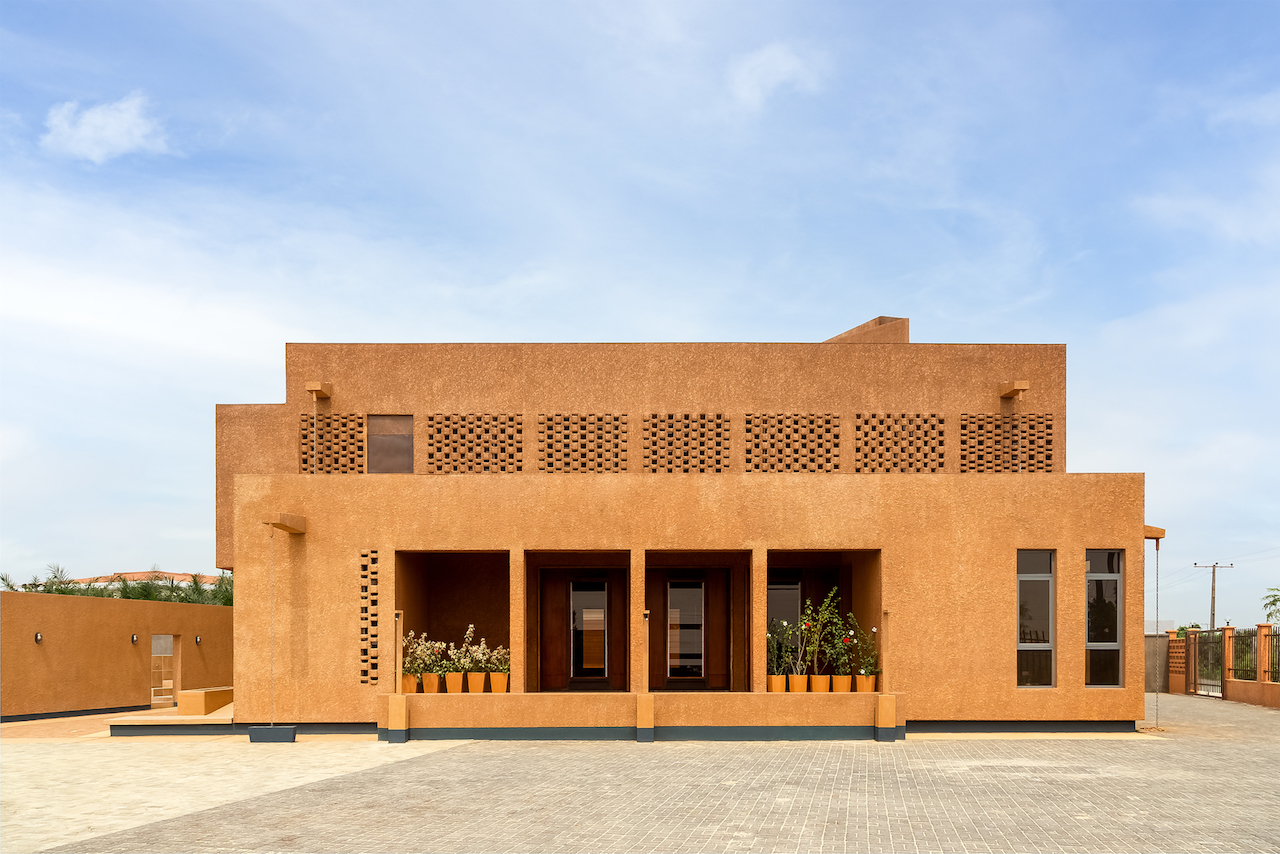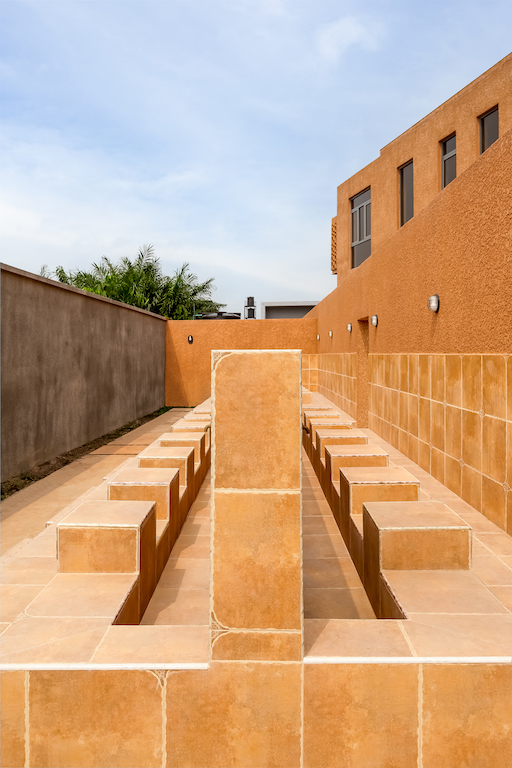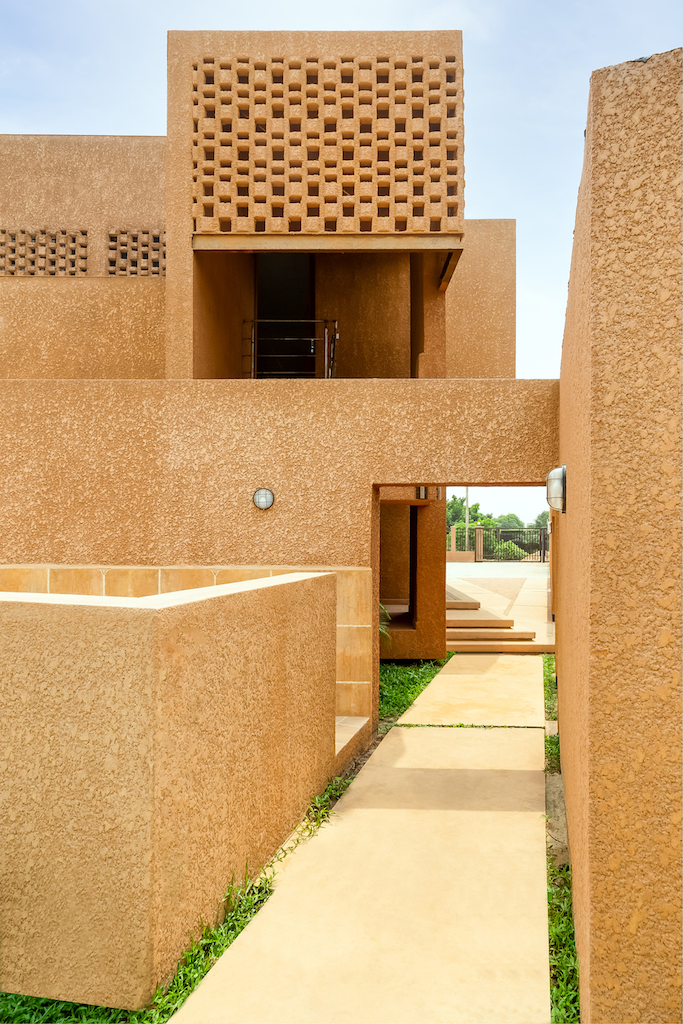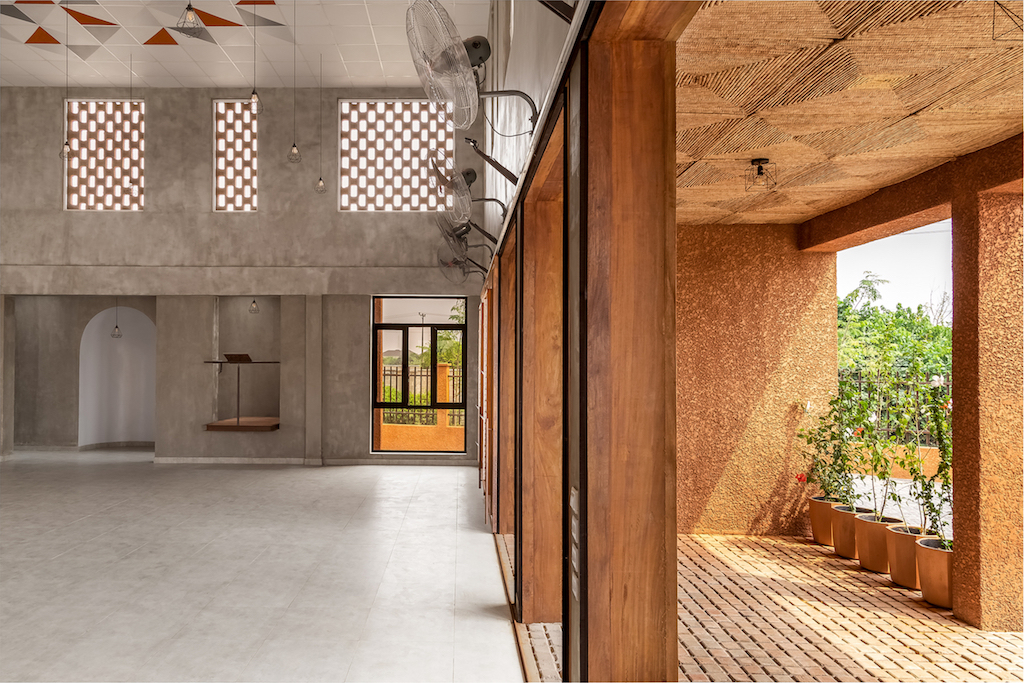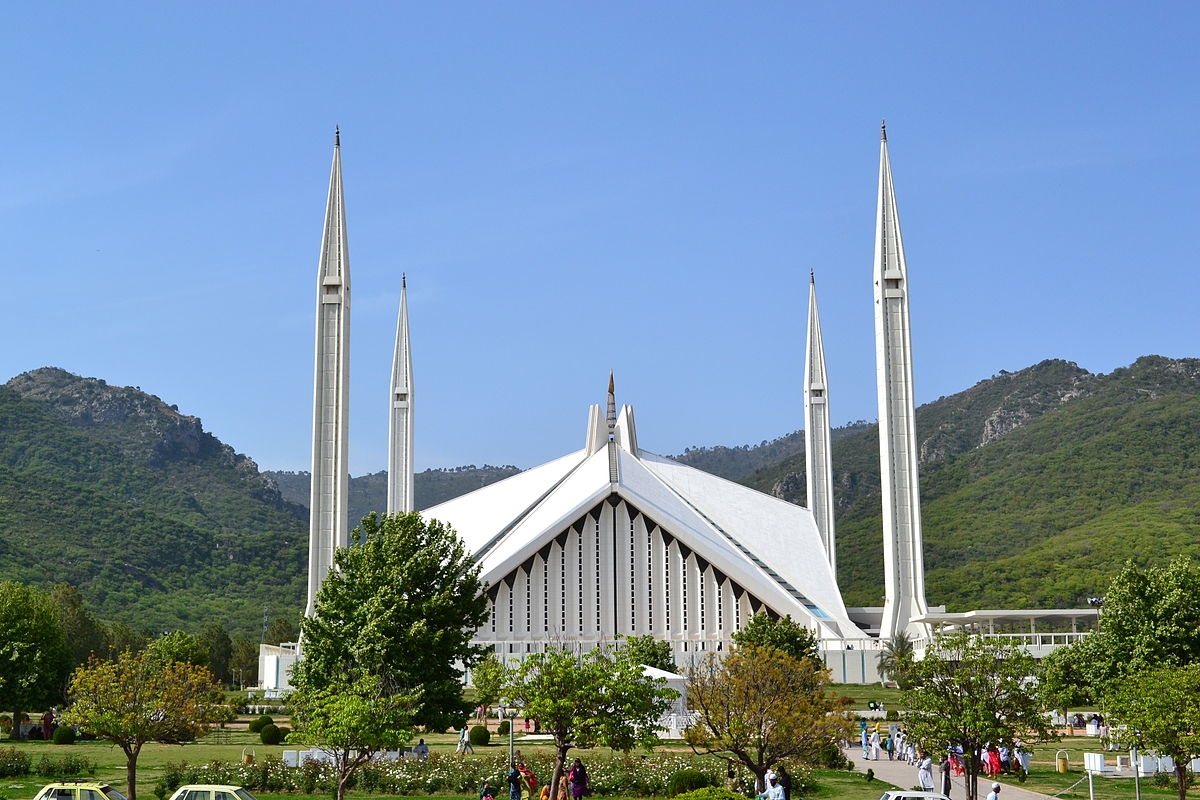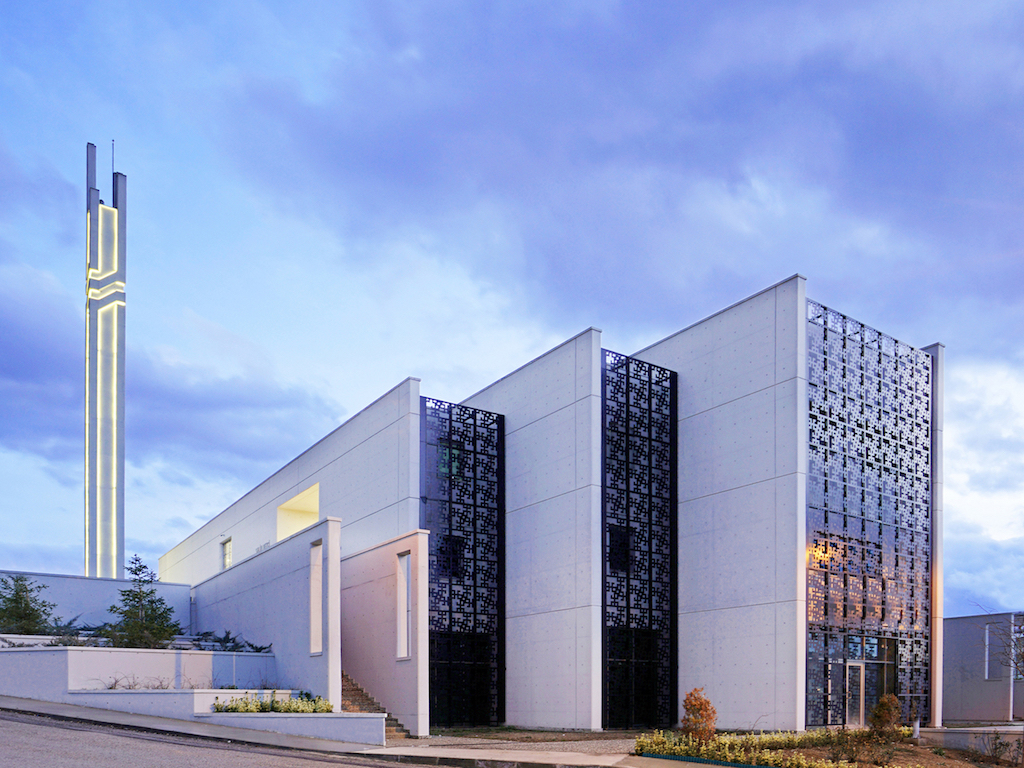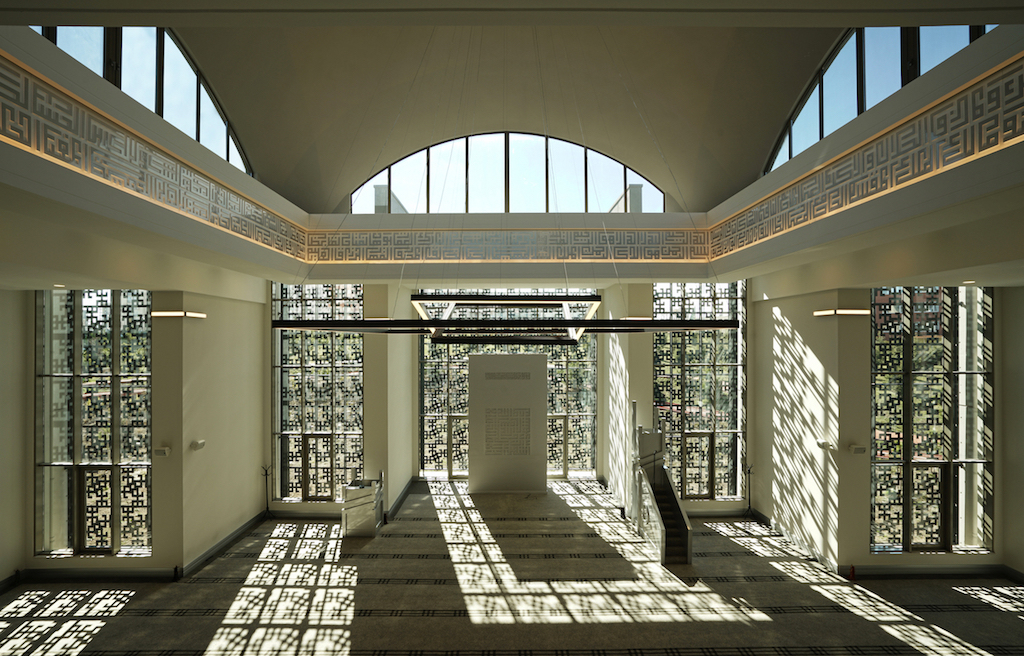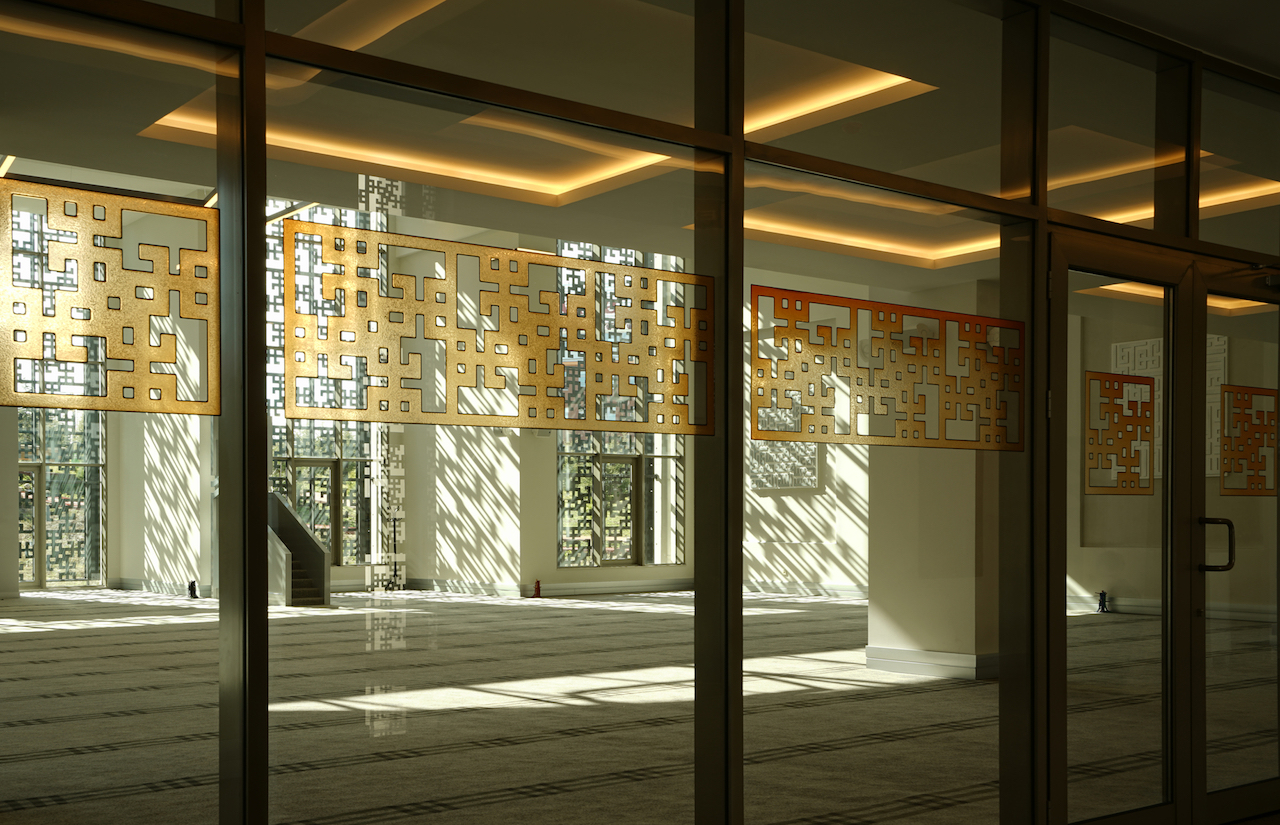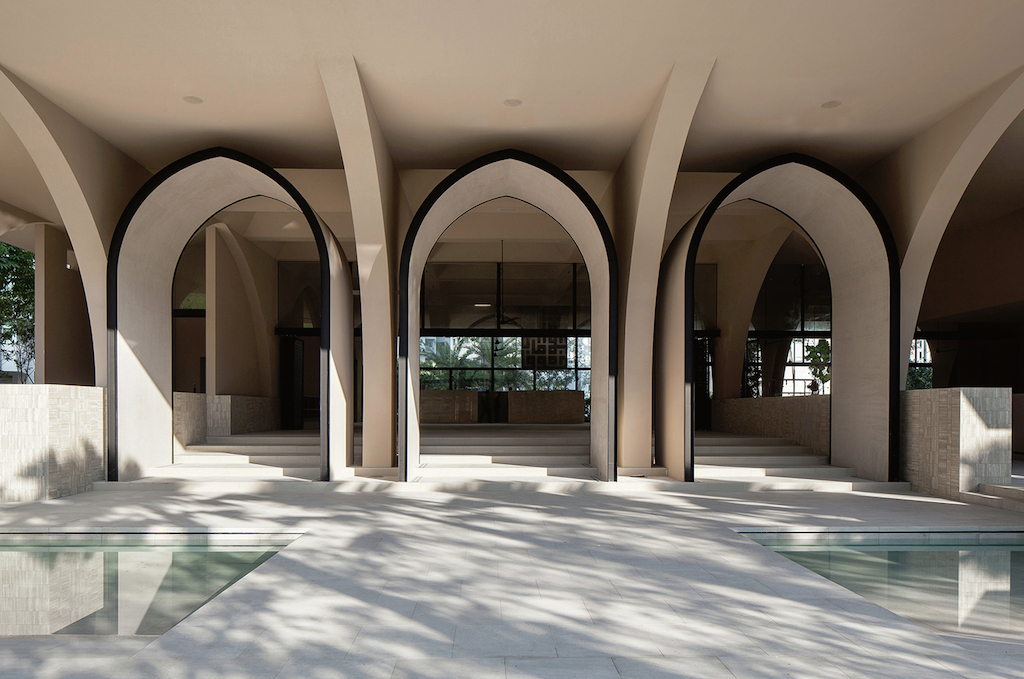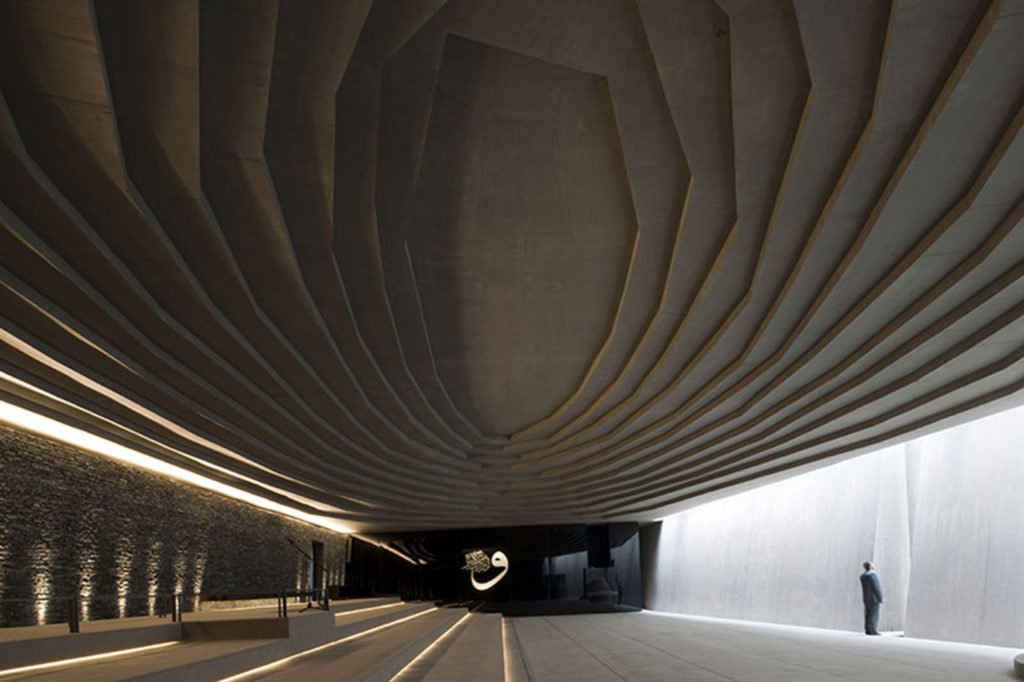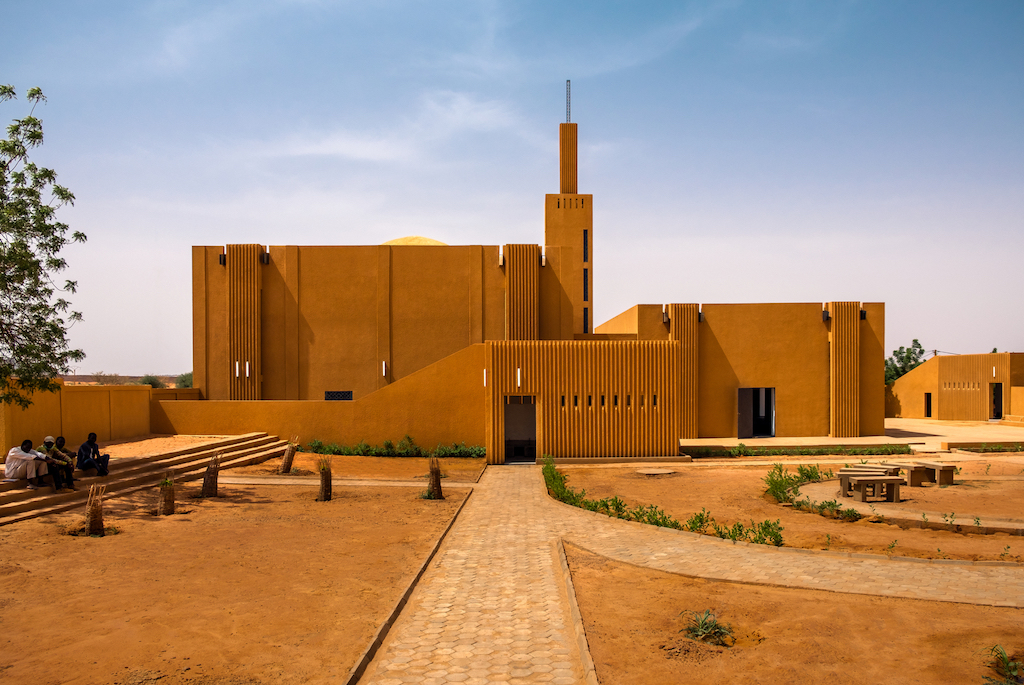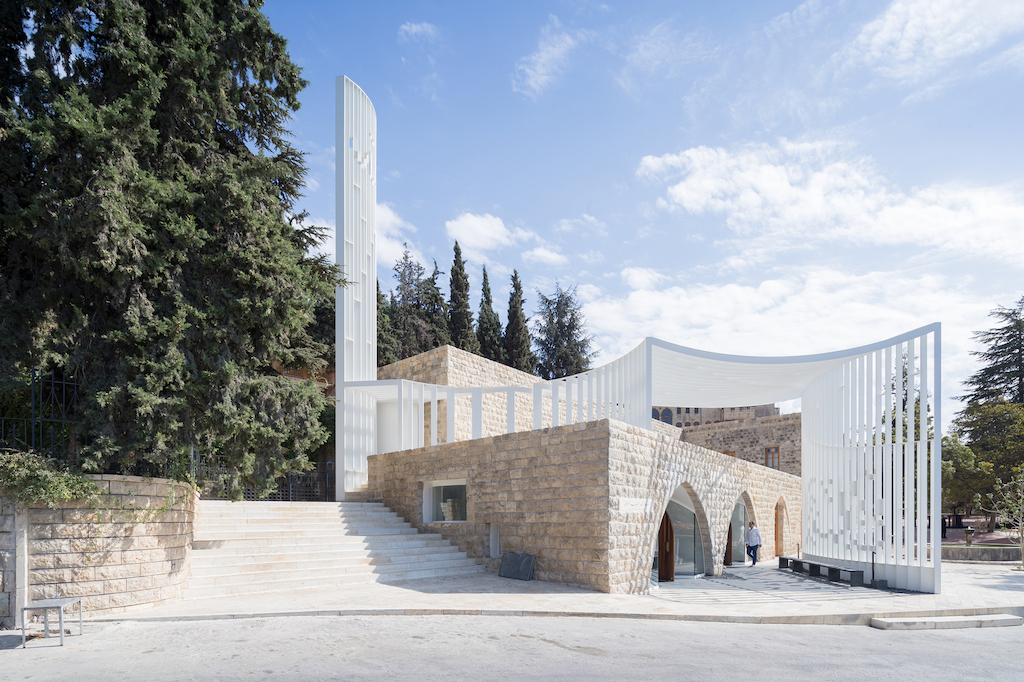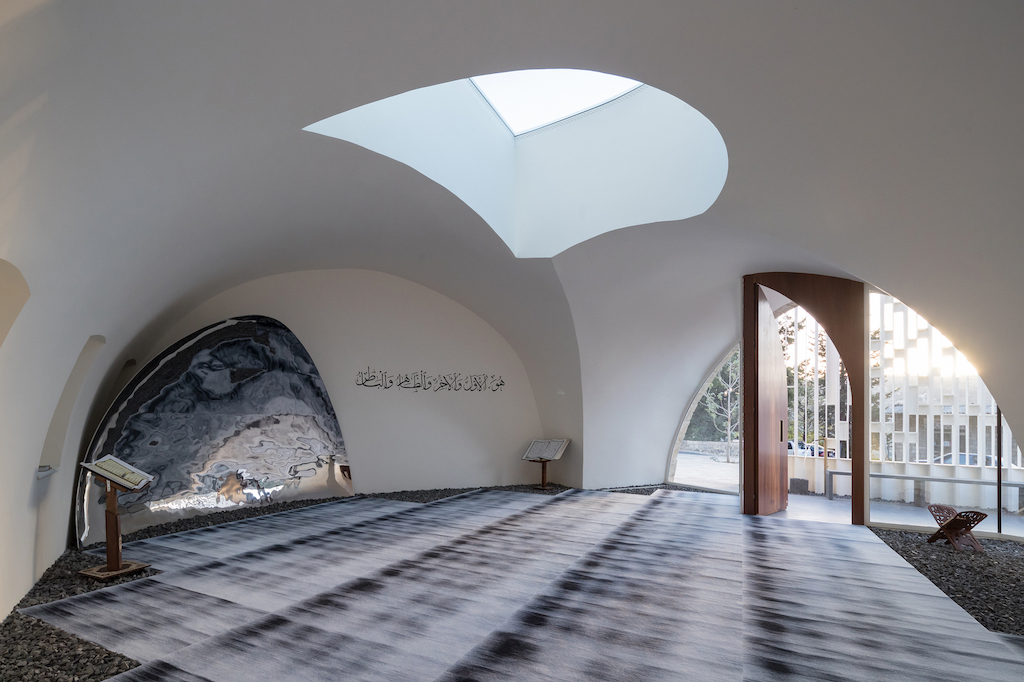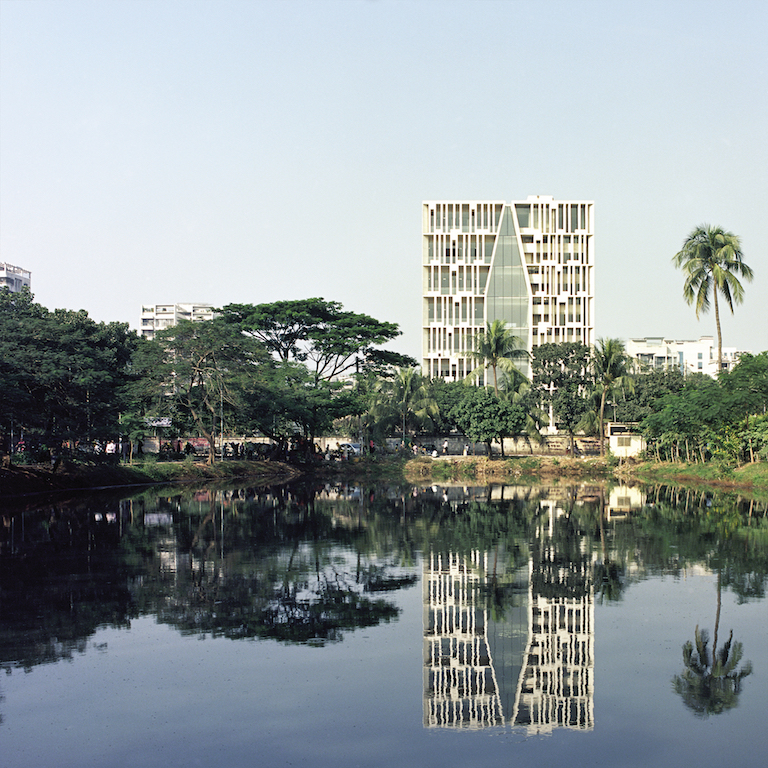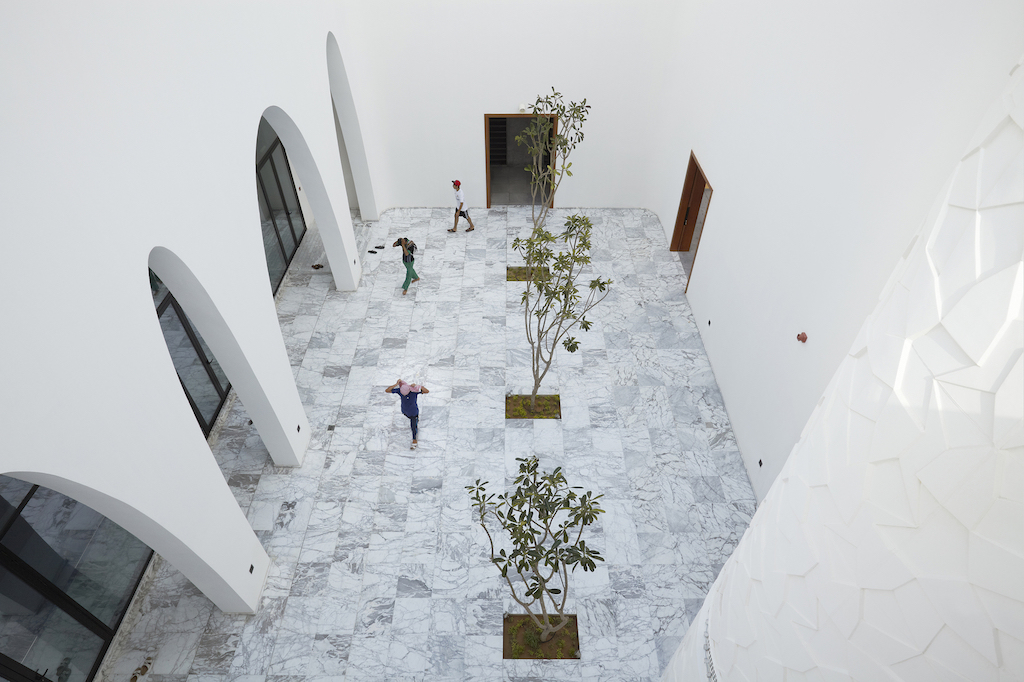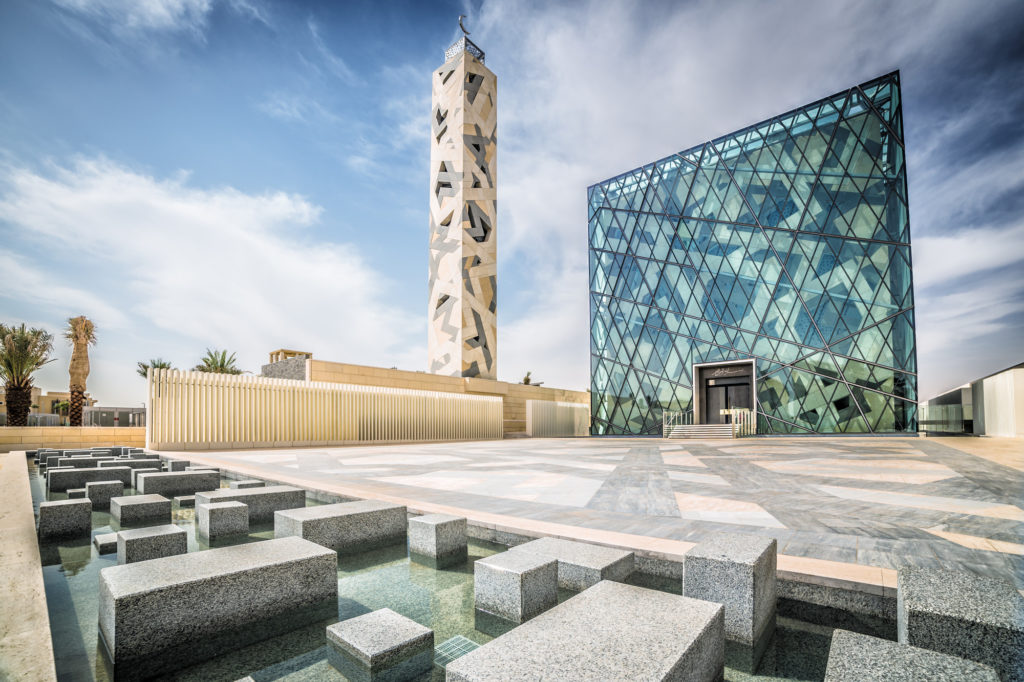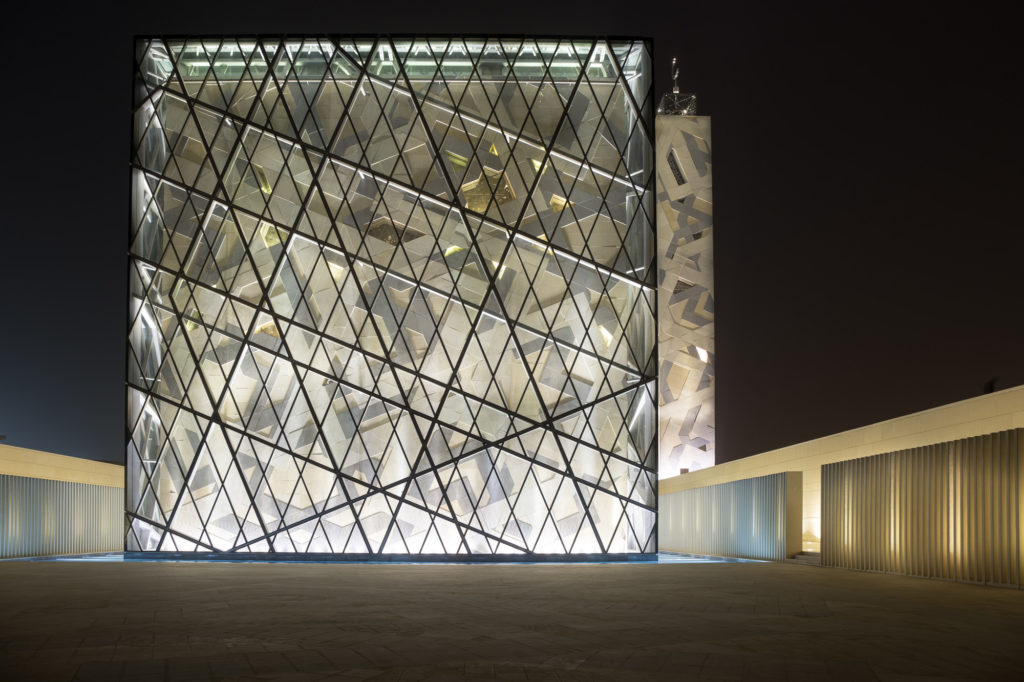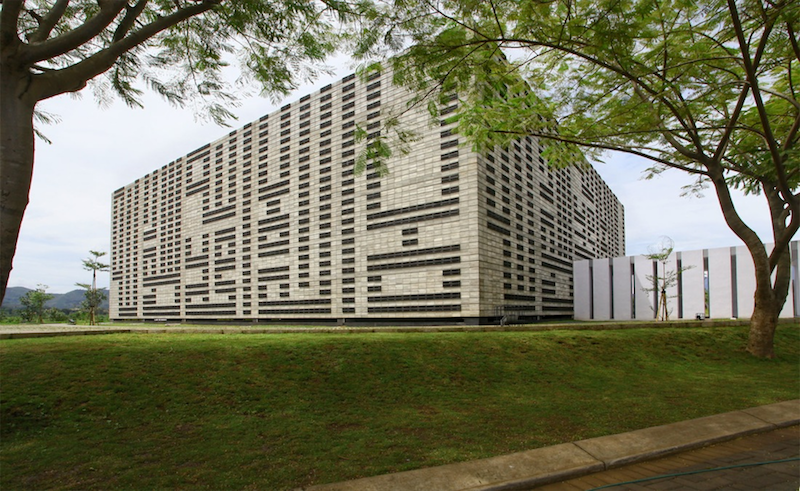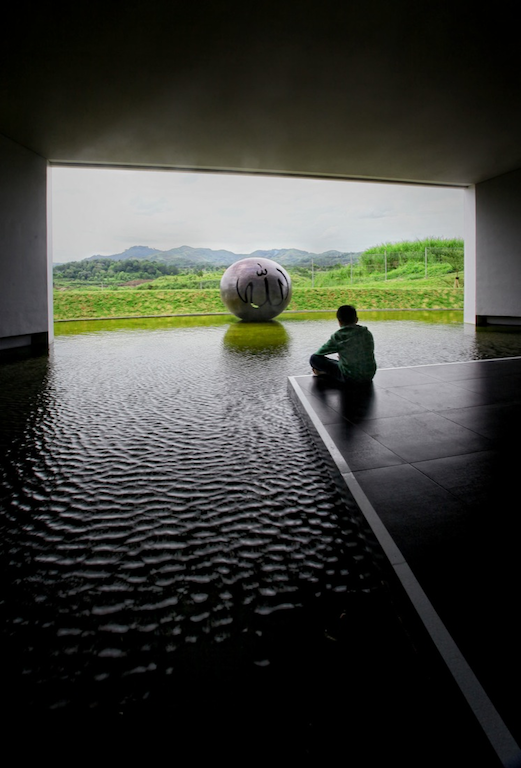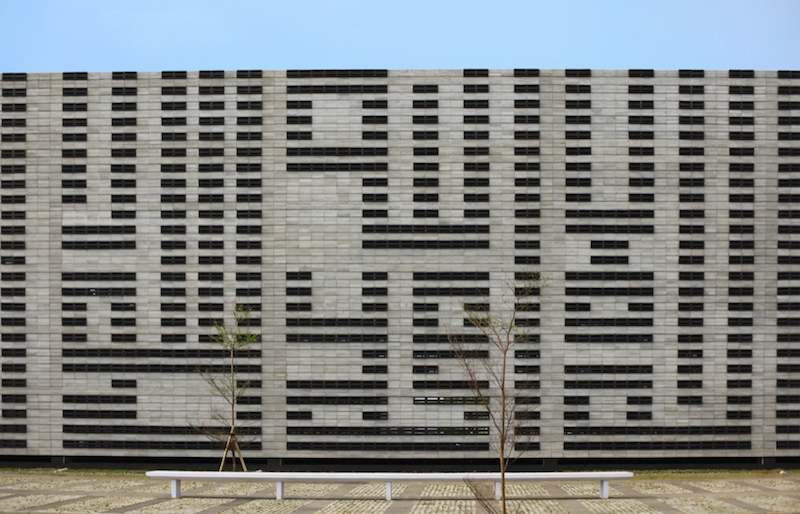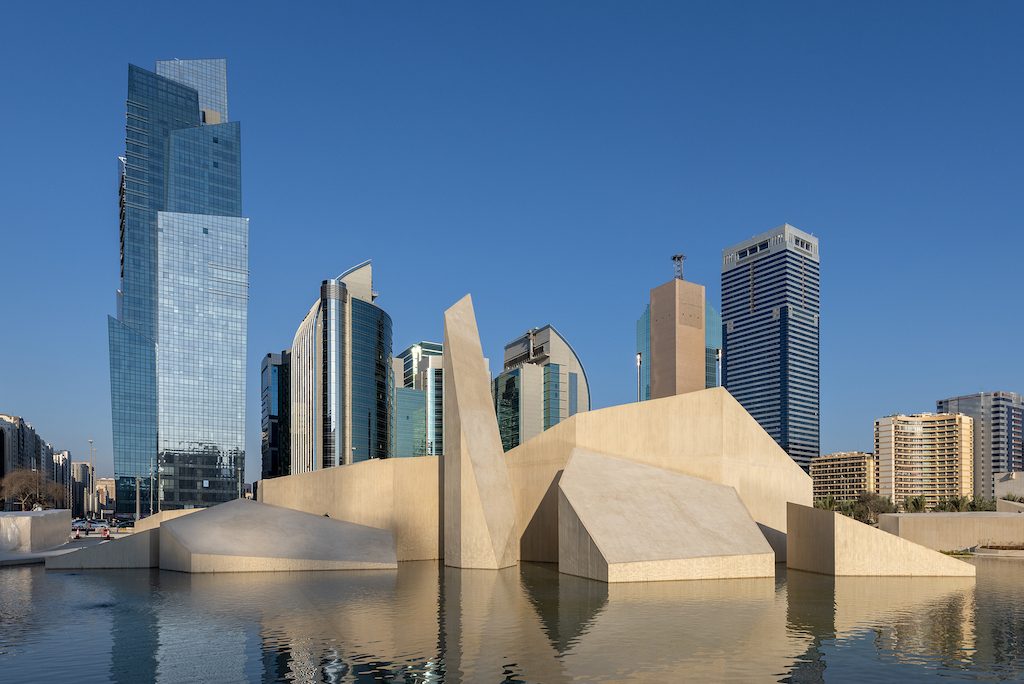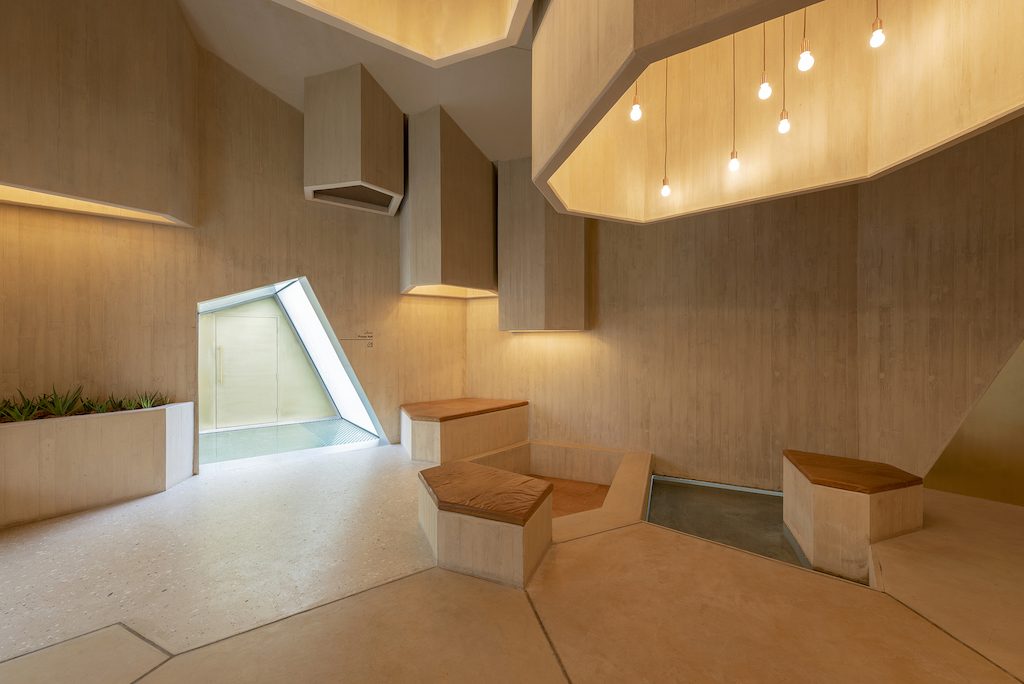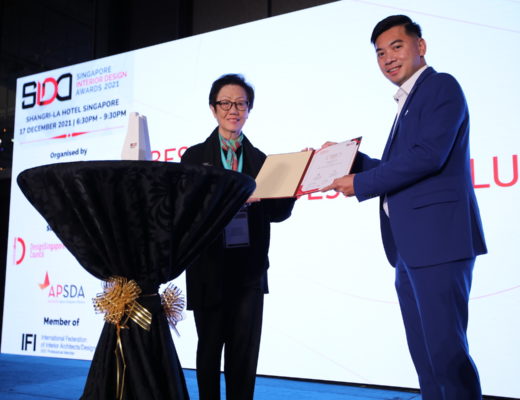Today marks the last day of Ramadan, the end of the month-long fasting period for the Muslim community and the eve of Eid-Al-Fitr. To observe the occasion, we are highlighting 22 contemporary and modern mosques around the world that have been reinterpreted by architects using indigenous materials and traditional Islamic motifs. Mosques have always been built on the foundation of creating not just a place to pray but as community spaces that bring people together for several purposes such as spiritual guidance, education, cultural awareness, social harmony, and charitable causes. The 22 mosques highlighted here aim to redefine traditional typology in evolving societies while preserving the context, sanctity of the space, and some of the vernacular construction techniques.
Main image: Masjid Al-Islah, Singapore by Formwerkz Architects; photo: Albert Lim
Al Ikhlas Mosque, Kecamatan Gedangan, Indonesia
Architect-in-charge: Muchammad Ubay; Consultants: Andy Rahman Architects
This mosque, officially known as Al Ikhlas Mosque, is located in the Puri Surya Jaya housing complex, Sidoarjo. But in the community, the 270m² mosque is popularly known as Sarang Lebah (Honeycomb) Mosque or An-Nahl Mosque, because honeycombs inspire most of the architectural elements used in this building. This mosque indeed takes the basis of the Qur’an’s 16th letter, the 68th verse of An-Nahl, which reads: “And your Lord revealed to the bees.” Bees are creatures that give a lot of parables, and benefits to humankind. This mosque aims to be the “honey” to the environment, not only “sweet” physically but also gives “sweetness” in a broader context to the world.
The mosque is based on the intelligence of Nusantara (outer islands in Bahasa), by making holes in the wall that enables the airflow from inside-out, so that the room inside the mosque becomes cooler. This hollowed wall made from vent blocks, which dominates the overall appearance of the mosque.
Terracotta and honeycomb (hexagon) are the two kinds of vent blocks used in this mosque, which are custom made by local craftsmen in Buduran. The stilt building concept – done by pulling the ground-level wall backward, to give the second floor the ‘stilt’ effect with stand-out columns in front – and umbrella concept are both adapted from Nusantara. To strengthen the impression, the vent block wall made in contrast: the lower part is terracotta, while the upper part is cement-colored. The umbrella concept was created by making a continuous pillar upwards, supporting the roof in the form of a “large umbrella,” which shades the existence of this mosque building.
Besides, this mosque consistently promotes the pilgrims’ essential concept, the world as a public and social entity, just like the bees, which are social creatures and hard workers. The most dominant look of this mosque is the hollowed wall in the form of hexagon-shaped vent blocks, similar to those of honeycombs. The hexagon honeycomb shape is also repeated in several parts of the mosque, for example, in the main wall as the pilgrims’ worship orientation.
This mosque must face the Qibla, so the square-like layout whose position is slightly tilted from the site, which precisely extends west to east. A compromise formed as well as the composition between parallel lines with the Qibla and site, resulting in a more dynamic plan and spatial planning. The mosque is also designed for people with disabilities, by providing a ramp and toilets for people with disabilities to make the premises and its facilities more accessible and inclusive.
When the Covid-19 pandemic occurred in 2020, the mosque was transformed into a “food bank” to help the disadvantaged local communities affected by the economic impact of the pandemic. Besides turning into a food bank, the Honeycomb Mosque provides basic sembako (food) packages, masks, and hand sanitisers to be distributed among the residents of the surrounding villages.
Chandgaon Mosque, Chittagong, Bangladesh
Architect: Kashef Mahboob Chowdhury
This mosque on the suburban periphery of the port of Chittagong in Bangladesh seeks to fulfil the traditional role of a mosque as both a place of spirituality and as a gathering place for the community. The architect began by identifying the essential elements of a mosque to create a new form and articulation for a typology that goes back for a millennium and a half. The result is this monolithic and spare mosque, pared down to two identical cuboid structures.
The first is the frontcourt, its heavy masonry walls punctuated with low, wide openings onto the surrounding landscape, with a large eyelike opening above. In the second volume, the naturally lit mihrab wall is balanced by an iconic, cut dome. While the apertures give a sense of openness and draw in light and ventilation by day, by night they allow light to shine out of the mosque like a beacon.
With its stark, geometric clarity, the Chandgaon mosque stands apart from many such structures that have reduced architectural features associated with the usual mosque type to the level of kitsch. It makes a definitive architectural statement in a different direction, pointing to the contemporary, to a desire to live in spaces that reflect the universal values of the present day.
Masjid Daing Abdul Rahman, Johor, Malaysia
Architect: Razin Architects
Located in the heart of Johor’s Nusa Idaman township, this mosque was originally designed in 2010 as a 200-person surau (Islamic prayer space) on a three-acre site. Even in its earlier incarnation, the prayer building designed by Razin Architects was naturally ventilated with wide overhangs and brickwalls. In 2017, the same practice was enlisted to design the actual mosque while keeping the surau intact.
The mosque is a 2,000m² three-storey cube of glass, brick and steel with a screen of faceted galvanised steel panels being one of its major highlights. Its triangular geometry, inspired by leaves in nature, is a contemporary interpretation of the traditional Islamic motif.
Al Assyafah Mosque, Singapore
Architect: Forum Architects
The design of this mosque adapted traditional elements to create contemporary versions of the arch, the minaret, and the arabesque.
The eight fair face concrete arches are three-dimensional and act to provide a free-span prayer space by transferring the load of the upper three levels. The minaret is designed as a sculpture held together by overlapping 25mm curved steel plates. The arabesque represents the Quran in its multiplicitous nature. It appears on the gates, fencing, custom-designed carpet and even the Chogma.
Beyond the imagery, the design brings forth universal attributes of spiritual attainment like calmness, a sense of oneness and a relationship with God. In the main prayer hall, this is created with an inward tilting four-storey wall to create a sense of awe. Natural light from slit-skylights creates an ethereal ambience. The ablution is conducted around pools of moving water, giver of life, and a natural source of cleansing.
Abijo Mosque, Lagos, Nigeria
Architect: Patrickwaheed Design Consultancy (PWDC)
It is a building donated to the Abijo community by Crescent Bearers 1939 Lagos, an 80-year-old association that focuses on promoting community-centered educational, religious and socio-cultural activities. The architecture of the building is based on the essential archetypal elements of a mosque which include the Mihrab, a semicircular niche reserved for the Iman to lead the prayer, which points in the direction of Mecca.
There is Minbar, which is to the right of the Mihrab, used by the Imam as a pulpit. The building is a double volume box accessed from three sides, with a mezzanine with a separate entrance, included to accommodate the female worshippers. To further increase the capacity of the mosque, the west, north and south walls have openings with sliding panels that open up completely to extend the prayer hall to the galleries for Friday congregational prayer service.
High-level louvre windows help manage the stack-effect ventilation of the building. The window openings are shaded with perforated sunscreens made from recycled paving stones salvaged from another project. Attached to the main building is the Imam’s office and the CB office to the north and south of the prayer hall. Outside on top of the building stands the Minaret (tower), which is symbolic as a beacon to Abijo.
The aesthetic of the mosque is based on the notion that the materiality had to be sustainable and locally sourced so that the frequent intervention through maintenance of the building was reduced considerably. A textured skin consisting of laterite, sand and cement mixture was used to coat the external face of the envelope of the masjid (a place of prostration). The insulation properties of the laterite wall, help keep the inside of the mosque cool. The objective was to avoid the usage of air-conditioning as a means of cooling the building during use. Earthy colours as a theme was also a priority, so for the doors to maintain the same hue as the external walls, mild steel door panels were acid-etched to give an earth-colour rusty finish. This same ‘burnt’ finish was applied to all the mild steel used for the pulpit, sliding door frames and the fence railings.
The large apertures in the external walls are framed with Iroko wood. The sliding doors have louvre windows incorporated into them to aid ventilation when the panels are not open. The ceiling of the main hall and the mezzanine screens consist of forms and visual illustrations of geometric compositions that can be fundamental elements for both the inside and outside religious buildings.
Faisal Mosque, Islamabad, Pakistan
Architect: Vedat Dalokay
Designed by Turkish architect Dalokay, it is the fifth-largest mosque in the world and the largest within South Asia, located on the foothills of Margalla Hills in Pakistan’s capital city of Islamabad. The mosque features a contemporary design consisting of eight sides of a concrete shell and is inspired by the design of a typical Bedouin tent. Without a typical dome, the mosque is shaped like a Bedouin tent, surrounded by four 260feet (79m) tall minarets.
The design features eight-sided shell-shaped sloping roofs forming a triangular worship hall that can hold 10,000 worshippers. The mosque still houses a library, lecture hall, museum, and cafe. The interior of the main tent-shaped hall is covered in white marble and decorated with mosaics and calligraphy by the famous Pakistani artist Sadequain, and a spectacular Turkish-style chandelier. Entrance is from the east, where the prayer hall is fronted by a courtyard with porticoes.
Yasamkent Mosque, Ankara, Turkey
Architects: A Tasarim Mimarlik, Ali Osman Ozturk
Yasamkent mosque represents research towards creating a sense of consciousness towards creating a peaceful continuity between traditional and modern values of cultural accumulation. Located in a relatively small plot within the new development area of Ankara, which also gives its name to the complex, Yasamkent mosque spanning an area of 2685m² is the search for balance between open and closed areas, modesty and expression, identity and convention as well as modernity and tradition.
The use of reinforced concrete and glass directly as a finishing element, the use of abstract and solid geometries, modest simplicity and minimalist architectural attitude directly refers to a contemporary architectural language whereas abstract Kufic expression of the minaret, as well as the abstract motives of fences, refer familiar traditional elements. With all these characteristics Yasamkent mosque must be seen as a challenge towards blurring the significant and ideological differences and popular architectural contradictions between traditional and modern.
Al Islah Mosque, Singapore
Architect: Formwerkz Architects
Located in the relatively new housing estate of Pungool, the 3,700m², Al-Islah Mosque is planned to serve the local Muslim community with a peak capacity of 4,500. Seeking the notion of an ‘open mosque’ and as an integral part of the local community, the new mosque aspires to be a model of openness, reflective of contemporary Islamic aspirations in Singapore. Extending beyond the formal manifestation of visual porosity, accessibility and climatic openness, it embraces the different needs within the Muslim community.
At the greater community level, it addresses the role of the mosque in promoting religious understanding. This ambition for openness posed many challenges in view of the tight site and its proximity to the neighbouring residential units. Physical porosity allows a visual connection to the neighbourhood and extends its spatial field beyond its boundary but poses the issues of sanctity and threshold expected of a mosque. Climatically, porosity offers many benefits of ventilation and daylighting but presents challenges of protection from the monsoon rain. At the urban scale, the massing strategy seeks to create more porosity and human scale. The arabesque screen facades of the three blocks are articulated differently to correspond to the different programmatic requirements and climatic responses. But collectively, the blocks with the minaret exude a dignified and subliminal presence while embracing the community spirit.
Mayor Mohammad Hanif Jummah Mosque, Dhaka, Bangladesh
Architect: Shatotto
Located adjacent to the Azimpur graveyard in Lalbagh, the Mayor Mohammad Hanif Jummah Mosque is a threshold space inspired by the Azam Shah Mosque built by the Mughals in the Lalbagh Fort. The new design is a departure from traditional mosques in both physical and philosophical designs, combining old and new ideas into a contemporary concept. A key feature derived from the Mughal mosque was the “Shaan” – an extended terrace attached to the entrance of the main hall. The Shaan provides additional prayer space when the interior is full but otherwise acts as a social hub for the community. The main hall is a large open space held up by cement columns with trunks that expand into canopies which hold up the slabs above, creating an indoor forest. Windows along the north and east walls flood the room with daylight while the perforated brick wall on the south filters light and noise coming from the road.
Basunah, Sohag, Egypt
Architect: Dar Arafa Architects
The Basunah is located in the hot and arid village of Basuna in a noisy, dusty and densely constructed area with encroaching residential buildings, a cemetery, cattle frequently moving back and forth on the road and a weekly makeshift small market right outside the main entrance of this place of worship posed a major challenge. The main dome was constructed using an Egyptian-made light block made of sand, lime and air. The remarkable lightness of the block decreased the building’s own-weight, in turn decreasing the required dimensions of all reinforced concrete elements. The architect also had to devise a special steel compass to guarantee the meticulous spatial positioning of every single block regardless of a mason’s skills and accuracy.
Mohammad Rasul-Allah Mosque, Shiraz, Iran
Architect: Paya Payrang Architectural Group
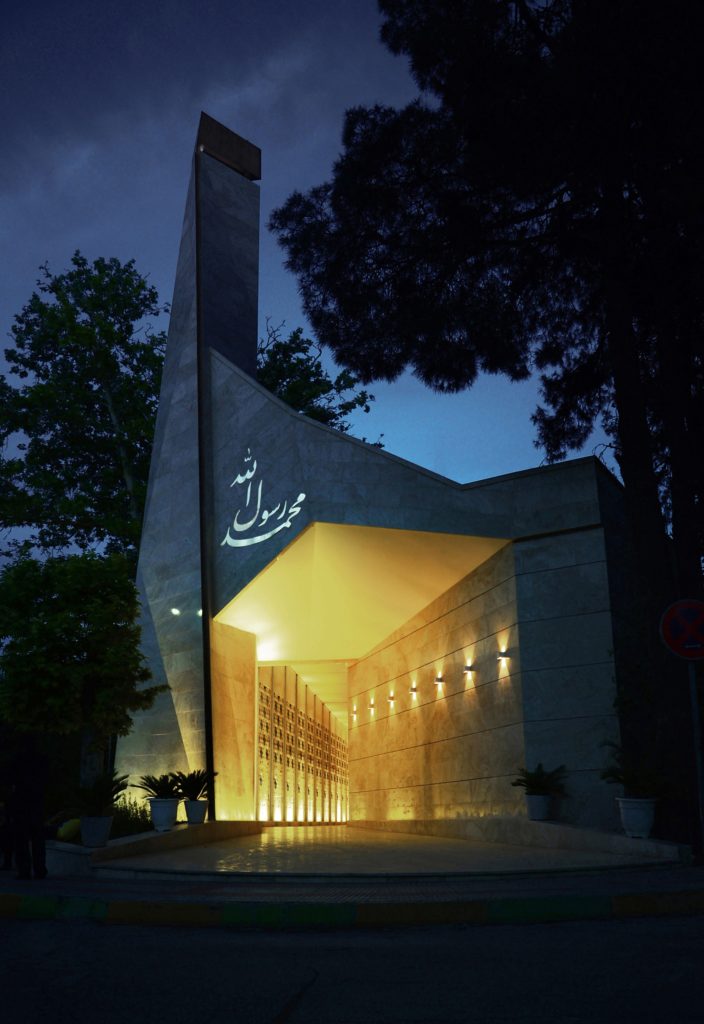
Mohammad Rasul-Allah Mosque, Iran by Paya Payrang Architectural Group; photo: Ahmad Mirzaee, Samaneh Motaghipishe
The brief for the architect was to design a mosque with the maximum capacity for prayers in the area of the old prayer hall at the site, being surrounded by 70-year-old trees as well as a hospital on the main street. The primary idea was formed on four challenges; the maximum capacity for prayers, preserving the trees, proximity to the main axis of the pavement, and the old prayer hall. These factors led to the concept of a mosque without a court where the whole area between the trees was regarded as the area that could be redesigned, leading to a geometrical shape that wove its way in through the scattered trees without harming them.
Al Ansar Mosque, Singapore
Architect: ONG&ONG
The Al-Ansar Mosque is a community mosque located along Green Link, between Bedok Reservoir and East Coast Park. The design of the mosque is focused on creating an open and inclusive atmosphere, which is inviting to worshippers and the community at large. Elements like the minaret and main prayer hall’s dome are retained from the past and integrated with new structures like the floating podium, which houses classrooms and auditoriums. With a 300-seater capacity, the auditorium can be used as an extended prayer space, as well as a multi-purpose venue for events such as weddings.
Sancaklar Mosque, Buyukcekmece, Turkey
Architect: Emre Arolat Architects
Located in Buyukçekmece, a suburban neighbourhood on the outskirts of Istanbul, the critically-acclaimed 700m² religious project aims to address the fundamental issues of designing a mosque by distancing itself from the current architectural discussions based on form and focusing solely on the essence of religious space. Located within a prairie landscape that is separated from the surrounding suburban gated communities by a busy highway, the high walls surrounding the park in the upper courtyard of the mosque depict a clear boundary between the chaotic outer world and the serene atmosphere of the public park.
The long canopy stretching out from the park becomes the only architectural element visible on the outside. The building is located below this canopy and can be accessed from a path from the upper courtyard through the park – blending in completely with the topography and creating a sensorial experience as one moves through the landscape, down the hill and in between the walls to enter the mosque. The interior of the mosque, a simple cave-like space, becomes a dramatic and awe-inspiring place to pray in solitude. The slits and fractures along the Qiblah wall enhance the directionality of the prayer space and allows daylight to filter into the prayer hall.
Hikma, Dandaji Village, Niger
Architects: atelier masomi and studio chahar
In the 9th century AD, Muslim scholars made remarkable contributions to the sciences and humanities in Bagdad’s Bayt al-Hikma, or House of Wisdom, a library and research centre housing the world’s largest collection of books for scholars to engage both theological and scientific matters. With the support of local leaders, women, and youth, the Hikma project, designed by atelier masōmī + studio chahar re-introduces these values embedded in Islam itself, by transforming a derelict mosque into a library that shares its site with a new mosque for the village of Dandaji in Niger.
The project is a culture and education hub where secularism and religion peacefully co-exist to cultivate minds and strengthen the community. To restore the old building to its previous glory, the original masons are invited to join the project’s team. In the process, they learn about adobe-enhancing additives and erosion protection techniques. Instead of the region’s traditional but scarce wood, the interior renovation uses metal for study spaces, partitions, stairs, and a mezzanine level, as a contemporary touch to a traditional space.
Amir Shakib Arslan Mosque, Moukhtara, Lebanon
Architect: L.E.FT Architects
This small mosque of 100m² included a renovation of an existing masonry cross-vaulted space and the addition of a minaret, grafted onto the existing structure as a symbolic landmark, next to the 18th-century old palace. A new civic plaza was created in what was before an adjoining parking space, turning the frontage of the mosque into a public square with seating, water fountain, ablution space and shading under a newly planted fig tree.
Given the non-alignment of the existing structure with the required directionality to Makkah, the design approach was first set to correct the orientation through a series of physical transformations and additions. The directionality towards Makkah became the only tool and language mobilised to shape the new mosque and its surroundings, at all scales, from the interior of the mosque to the outdoor plaza.
Gulshan Society Mosque, Bangladesh
Architect: Kashef Chowdhury – Urbana
The urban plot allocated for this mosque was relatively small – only 741m² – but a survey suggested that the mosque would need to accommodate a large congregation. This necessitated reimagining the mosque typology into a vertically stacked volume. Planned for 2,500 devotees, the building is presently attended by up to 4,500 people for the weekly Friday prayer. Because of the limited size of the plot, the court-prayer hall sequence had to be substituted for a pragmatic approach. The entrance, for example, is immediate: a flight of steps from the sidewalk directly leads to the main vestibule and prayer hall.
All the floors are accessible by generous stairs and elevators, taking visitors to six upper levels. The interior spaces benefit from good penetration of natural light and ventilation, made possible by the employment of a jali or screen structure, which wraps the building and generates its unique form and façades, while ensuring protection from rain and solar heat gain. The entire structure is white cast concrete, giving it the appearance of a monolith in a city where otherwise the fabric and skyline is formed of generic residential and commercial buildings.
Al Warqa’a Mosque, Dubai United Arab Emirates
Architect: waiwai architects
Designed with the intention of capturing the historical premise of a mosque as a communal space for worship, Al Warqa’a Mosque is a structure that also functions as a gathering place for the community. With the proliferation of the iconic Turkish Central Dome mosque typology in the UAE, the architects – Wael Al Awar and Kenichi Teramoto – sought to return to a simpler design that is less focused on the mosque as an icon, and more as a social space.
The 1,400m² echoes the spatial simplicity of Prophet Muhammad’s 7th-century house in Medina, which is considered the first mosque in history. In what came to be known as the Arab Hypostyle typology, the original mosque structure was distinguished by an open courtyard surrounded by rooms supported by columns. The design approach behind this layout was influenced by an understanding of the mosque as a multifunctional space for the community to congregate and socialise in after prayer; in this way it is seen as an extension of its immediate environment.
Punchbowl Mosque, New South Wales, Australia
Architect: Candalepas Associates
The 549m² project, located 17km outside of Sydney’s central business district, seeks to establish a new home for the Australian Islamic Mission and provide a complex of buildings to facilitate learning and religious worship for local community members that follow the Muslim faith. The development was undertaken in two stages, with Stage 1 being the construction of the Mosque accommodating approximately 300 worshippers and Stage 2 being the construction of community buildings.
The buildings are arranged around a quadrangle partially open to one side, which provides an internal outlook and affords privacy to students and community members. This configuration creates two adjoining but separate courtyards, providing the separation of the primary daytime functions required in the client’s brief to the architect. The first more public of the two courtyards, is accessed directly from the street and abuts the mosque. This courtyard is used primarily as an orientation and congregation space for worshippers entering and exiting the Mosque. The second courtyard is larger and more private, accessed through, but physically separated from the first courtyard.
APSARC Mosque, Riyadh, Saudi Arabia
Architect: HOK
The spiritual centre of the King Abdullah Petroleum Studies and Research Center (KAPSARC) community is a mosque within the linear park at the heart of the site. Highly visible throughout the community, the sanctuary is approached through outdoor courtyards aligned with Islam’s most sacred places – Mecca and Al Kaaba. The prayer hall is set within a reflecting pool and reached from elevated glass bridges leading to its entrances. This procession represents the transition of leaving the hubbub of the outside world to enter the sacred realm. The reflecting pool glows at night, giving the illusion that the entire building is floating over the water. To either side of the prayer hall, curving walls screen supporting functions, including ablution spaces and imam’s office. The main prayer hall is designed as a 75-foot-square cube sheathed in a dynamic, layered skin. The outermost layer of glass is separated from an inner layer of stone-clad concrete by three feet. The 115-foot-tall minaret is designed to complement the mosque in its similar patterns of stone cladding and windows.
The exteriors of both structures are designed to represent an abstracted version of a traditional Arabic pattern and create an ever-changing experience of light and shadow. At night, the glass box becomes a lantern in the landscape, punctuated with points of light. Custom, square pendants are arranged in a grid pattern and suspended by cables to illuminate the interior. The main prayer hall accommodates 200 men, while a mezzanine level accommodates 100 women. Wrapping its walls and ceiling is a modern interpretation of an Arabic screen wall (mashrabiya) that glows with natural light from windows and skylights to brighten the modern space.
Al-Irsyad Mosque, Kota Baru Parahyangan, Indonesia
Architect: Urbane
The first thing that might catch one’s attention about this mosque is the absence of a dome, which is almost always a quintessential characteristic of mosques. However, the architects have clarified that the dome is not a cultural or religious identity, hence not a necessity when it comes to designing an Islamic place of worship.
The architecture of this 8,000m² mosque is unique in that it uses stacked stones as the main façade to create a tectonic effect while embedding Islamic text and calligraphy on the façade as a graphic element and reminder prayer. The primary shape of the mosque takes the form of a square, which seems the most efficient since Muslims pray in straight rows facing a specific direction or the Qiblah.
The structural columns are arranged in such a way that the façade seems like it is not supported by any frame. This shape also alludes to Ka’bah, the most important structure in the Islamic world, to which all Muslims’ prayers are directed. With a capacity to accommodate approximately 1,000 people, the mosque is also designed to ‘blend in’ with nature. The stacked stones allow for natural ventilation without the need for air-conditioning. Surrounded by water, the ambient temperature around the mosque is lower during the hot season.
Qasr Al Hosn: Al Musallah Prayer Hall, Abu Dhabi, United Arab Emirates
Architect: CEBRA
Located in the United Arab Emirates‘ capital Abu Dhabi, the historic 18th-century Qasr Al Hosn Fort was recently restored. As an important element of the cultural park – part of the 140,000m² complex – the 1,100m² Al Musallah prayer hall, designed by Denmark and Abu Dhabi-based multi-disciplinary firm CEBRA, is located at the north-eastern corner of the site as a series of small interconnected buildings that form a cave-like structure pushed halfway into a large water feature.
The Musallah stands in water to create a subtle privacy barrier without using walls, which provides calm and secluded spaces for prayer without visual disturbances. At the same time, the water is used as a symbol of spiritual purification flowing around and in between the interior functions. The individual spaces are connected by glass tubes bridging over water, which symbolically purifies the mind when moving through the light-filled passages from one area to the next.
The Islamic Centre and the Mosque, Rijeka, Croatia
Architects: Dora Vlahović, Luka Vlahović, Dubravka Đurkan-Horvat and Davor Mauser

The Islamic Centre and the Mosque, Rijeka, Croatia by architcets Dora Vlahović, Luka Vlahović, Dubravka Đurkan-Horvat and Davor Mauser
The mosque is located in Gornji Zamet that offers a spectacular view of the Kvarner Bay off the Adriatic Sea. Its dome is shaped in five separate parts that visually constitute a single object. The architects sought inspiration from the rich traditions of dome construction from Ottoman mosques on the shores of the Mediterranean. With his sculptural approach he gave ‘the new meaning to the old theme. Sadly, one of the main collaborators, sculptor Dušan Džamonja passed away before the mosque was completed.
The successful ‘playing’ with basic geometric shapes led to the fact that the building is considered more as a functional sculpture, intended for culture and religion, rather than the usual architectural building. The monumental indented sphere with a stainless steel protective layer, composed out of six spherical sections in the contours and glass crevices in which appears the Islamic half-moon symbol, rises from the square paved in travertine stone which had reminded Džamonja of desert sand. The square underneath the underground level of the Islamic Centre was conceived as a pedestal in the centre of which is the mosque with a 23-metre-high minaret.
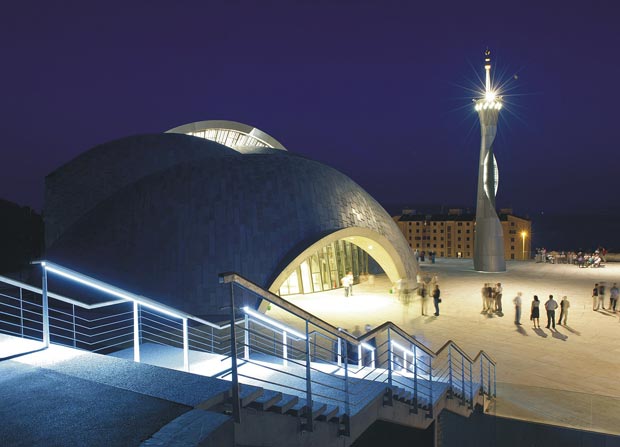
The Islamic Centre and the Mosque, Rijeka, Croatia by architcets Dora Vlahović, Luka Vlahović, Dubravka Đurkan-Horvat and Davor Mauser
The complex is decorated with three fountains since the element of water has a special meaning as a symbol of purity in Islamic architecture. The first level under the mosque contains hospitality facilities open for all users, a multi-purpose hall for various social and cultural gatherings, offices and verandas – special rooms intended for discussions among its female attendees. The Islamic Centre includes classrooms for religious classes and a kindergarten for preschoolers. The complex has an underground garage and an outer area for walks. The section for prayer can hold up to 1,400 people.


